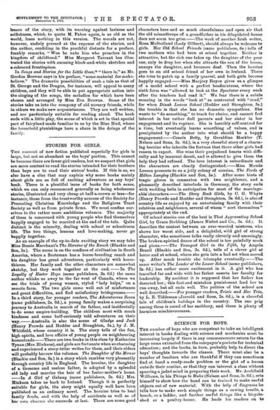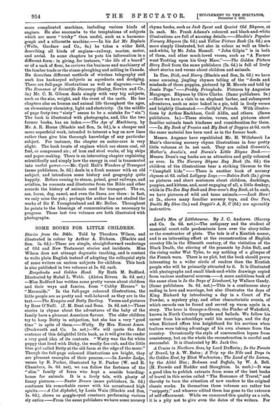SCIENCE FOR BOYS.
THE number of boys who are competent to take an intelligent interest in books dealing with science and mechanics must be increasing largely if there is any commensurate return for the large sums extracted from the ratepayer's pockets for technical education ; and the books, in turn, probably help to direct the boys' thoughts towards the classes. There must also be a number of teachers who are thankful if they can sometimes find at hand a ready-made problem or the gist of a lesson outside their routine, 80 that they can interest a class without spurring a jaded mind in preparing their work. Mr. Archibald Williams, in his Things to Make (Nelson and Sons,3s. 6d.), seta himself to show how the hand can be trained to make useful objects out of raw material. With the help of diagrams he tells how to make such simple things as a sawing trestle, a bench, or a ladder, and further useful things like a bicycle- shed or a poultry-house. He leads his readers on to
more complicated machines, including various kinds of engines. He also succumbs to the temptations of subjects which are more "tricky" than useful, such as a harmono- graph and a silhouette machine.-In his Let Me Explain, (Wells, Gardner and Co., 6s.) he takes a wider field, describing all kinds of engines-railway, marine, motor, and aerial. In some chapters he puts his information in a different form : in giving, for instance, "the life of a board" or of a sack of flour, he reviews the business and machinery of the lumber trade or the steam-ploughing and milling in Canada. He describes different methods of wireless telegraphy and such less hackneyed subjects as aqueducts and dredging. There are full-page illustrations as well as diagrams.-In The Romance of Scientific Discovery (Seeley, Service and Co., 5s.) Mr. C. R. Gibson deals simply with very big subjects, such as the size, weight, and the crust of the earth. He has chapters also on human and animal life throughout the ages, on elementary chemistry, light and electricity. (In the middle of page forty-two "sixty" seems to be a mistake for "six.") The book is illustrated with photographs, and, like the two former books, has an index.-The Age of Machinery, by Mr. A. R. Horne (Blackie and Son, 28. 6d.), is a cheaper and more superficial work, intended to interest a boy on new lines rather than give him thorough knowledge of any particular subject. For instance, the chapter on motor-cars is very slight. The book treats of engines which use steam coal, oil fuel, or compressed air ; of iron and steel works, of big ships and paper-making. There is an interesting chapter explaining scientifically and simply how the energy in coal is transmuted into useful power.-Mr. Cyril Hall's Wonders of Transport (same publishers, 3s. 6d.) deals in a fresh manner with an old subject, and introduces some history and geography quite happily. Before coming to steam, petrol, great railways, and aviation, he recounts and illustrates from the Bible and other records the history of animals used for transport. The ox, ass, horse, dog, camel, and even the llama are there : in fact, we only miss the yak ; perhaps the author has not studied the works of Sir F. Younghusba.nd and Mr. Belloc. Throughout be points to the blessings of communication as necessary to progress. These last two volumes are both illustrated with photographs.



































































 Previous page
Previous page